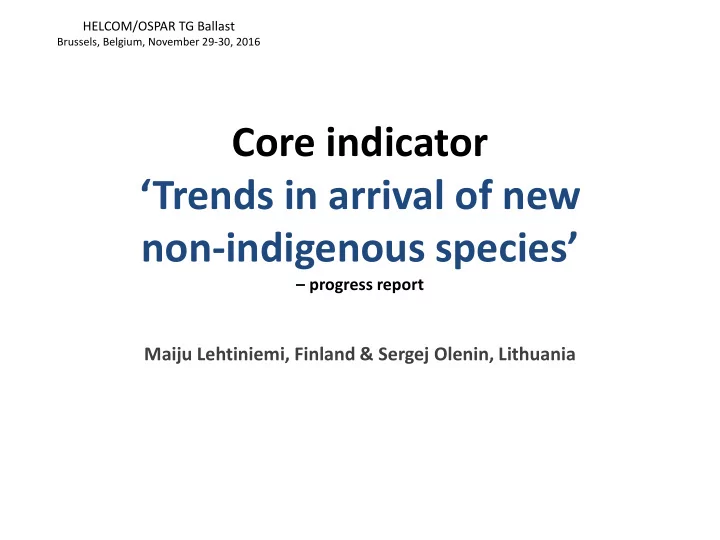

HELCOM/OSPAR TG Ballast Brussels, Belgium, November 29-30, 2016 Core indicator ‘Trends in arrival of new non-indigenous species’ – progress report Maiju Lehtiniemi, Finland & Sergej Olenin, Lithuania
Progress towards indicator updating Environmental target: The indicator: No new introductions of The number of new NIS in an NIS per assessment unit assessment unit through human activities (recorded and compared with during the assessment the initial or periodic period assessment) • The next assessment period for the indicator will be 2011- 2015 to feed information to HOLAS II • The data needs of the indicator can be fulfilled by using AquaNIS database. • At present country wise information is already available • Georeferenced data is needed to report on sub-basin scale • This work is under way.
The technical precondition for the NIS indicator is the availability of verified and continuously updated source of data on NIS introduction events, e.g. a central NIS database AquaNIS is a reporting platform for non-indigenous species in the ICES area since 2015 (ICES WGITMO annual report, 2014). The Baltic Sea data in AquaNIS was recently updated by the representatives to ICES WGITMO (scientists from all Baltic Sea countries). The system was created as the outcome of the EU funded project VECTORS. AquaNIS inherited multiple NIS data collections from earlier projects and initiatives, including the Baltic Sea Alien Species Database, earlier supported by HELCOM.
AquaNIS: geographical coverage ( free access data) Data is arranged using the Large Marine Ecosystems (LME) concept. E.g.: LME 23. Baltic Sea Large Marine Ecosystems for which data is available in AquaNIS
Data stored in AquaNIS Taxonomy • Recipient region • (based on World Register of Marine Species) (country coast) Year of the introduction Native origin • • Species status Biological traits • • (life form, sociability, characteristic feeding method and mobility, (non-indigenous or cryptogenic) reproductive frequency, reproductive type and developmental Population status • traits) Pathway of introduction • Salinity tolerance range • (e.g. ‘Vessels’) Vector of introduction Molecular information • • (whether molecular markers are available for a species - provides (e.g. ‘Ballast water’) tools to identify NIS, their origin and history of introduction, their Salinity range • detection and monitoring). (in the recipient region) Association with vessel vectors Temperature range • • (verified records of a species transfer by ballast water, biofouling, Habitat characteristics • tank sediments, etc. from any world region)
nNIS indicator Number of new NIS found in the Baltic Sea states during the 2010 –2016 period, i.e. since the initial assessment for MSFD. (Note: two regions of Russian Federation) 1 1 Species new for a particular • country = nNIS L1. 6 3 Some of these species were • 2 recorded earlier in other Baltic 2 Sea countries and have spread 2 further since 2010. Distinguish between the 12 • 7 1 Primary introduction and the Secondary spread.
nNIS indicator: the Baltic Sea scale Number of NIS, which are new at the scale of the entire Baltic Sea (recorded since 2010) Hot spots (“windows of • introduction”) for the Baltic 1 1 Sea ( nNIS L2) – primary • 1 introductions at the scale of the entire Baltic Sea 7 2 1
How nNIS indicator is related to the environmental target? Pathways of NIS introduction Level of certainty for 12 NIS the pathway “Vessels” new at the scale of the Baltic Sea (one NIS shared between PL and GER) L2 Take away note: nNIS , as such, has little information value without further breakdown to pathways and vectors involved in transmission of new species, therefore an environmental target should be related to a particular pathway/vector (e.g. ‘ No new introductions by ballast water ’).
Recommend
More recommend